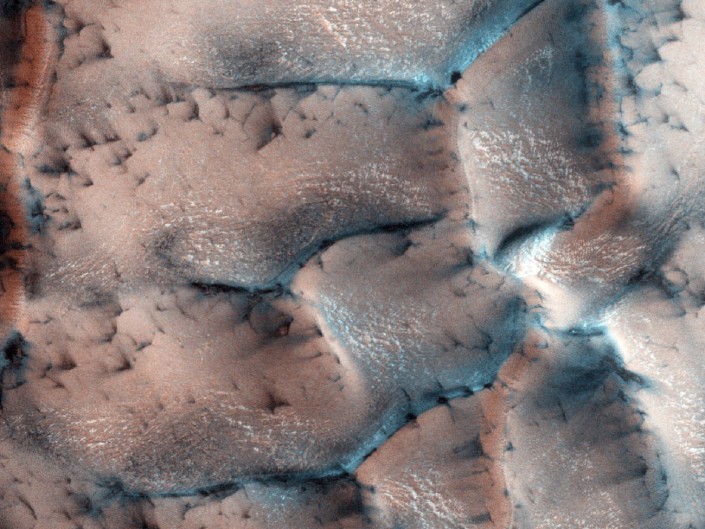Mars Reconnaissance Orbiter seems to have spotted ice on Mars

The fact that Mars had a warm and humid past, with water running over the surface, says many scientists. And indeed, there is indirect evidence that Mars used to have liquid water, a lot of water. There are other opinions, but they are not as popular as this.
Now almost no one doubts that the water on Mars is preserved in the form of ice. Moreover, ice was found on the Red Planet in 2008 by the Phoenix spacecraft . Ice was found at the pole. Now scientists say that it should be distributed in other regions, and the thickness of the ice deposits can reach 100 meters.
Now, it seems, the first (or second?) Step has been taken in detecting ice on Mars. This move made the Mars Reconnaissance Orbiter , equipped with a very high-quality camera - the best of those that have ever been sent to other planets. Gradually, the MRO discovers more and more new secrets of Mars, and now, as far as can be judged, it has found water ice visible from orbit.
In any case, a team of researchers noticed in some photos sections of rocks cast in blue. It is clear that we can see all this after processing images with light filters, but, nevertheless, there is no doubt that the color is really blue. These rocks are found in the middle latitudes of Mars; they are usually covered by surface bulk material, which is a product of erosion.
There is a blue "rock" on the slopes with an angle of about 55 degrees. More gentle slopes are covered with the same products of erosion, which were discussed above. Because of them, scientists cannot observe other breeds. But where the slope is steep, the material seems to crumble and opens the veil of secrecy. The thickness of the ice deposits (there is little doubt that it is ice) is about 100 meters. This was enough to conduct observations from orbit. There are no craters in this region, which indicates its relative youth.
The authors of the study believe that they did find ice, possibly mixed with dust. Maybe it was formed at a time when snowfall was possible on the planet. Changes in the color of "deposits", according to scientists, indicate the layering of ice, which was formed gradually, layer by layer. Most likely, the dust froze into the ice, so that its color is quite unusual. But the layers allow us to study the evolution of Mars over time - of course, if someone gets to them in order to start studying.
Now those ice (if it is ice), which are observed by scientists, are covered with a layer of dust, the thickness of which reaches two meters in many places. According to experts, the water on Mars began to freeze from the poles, after which freezing continued in other regions of the planet. After everything froze, the ice gradually sublimated, becoming thinner. This is a slow process, reducing the thickness of the ice cover is about 1 mm per year. But if we consider that this process continues for millions of years, the ice could be much less than before.
Scientists believe that the ice that is visible is only a small fraction of the real volume of frozen water on Mars. A radar survey indicates that what was previously considered rocks may actually be ice. Of course, remotely difficult to speak with 100% certainty, but it really can be ice.
The latter assumption is supported by the results of the analysis of data transmitted by the MRO. Bare rocks were studied using a CRISM spectroscope. As a result, scientists have found that these rocks contain frozen water. Data from the THEMIS system, which determines the surface temperature, showed that ice forms a rather thick layer, and not just a crust. According to the authors of the study, this discovery shows that there is more water available to potential colonists on Mars than previously thought. As far as can be judged, the occurrence of ice at a shallow depth prevents the destruction of layers.
All this will help to find out the next spacecraft, which will go to Mars, and then we all will know exactly what to expect future colonists on the Red Planet.
All Articles